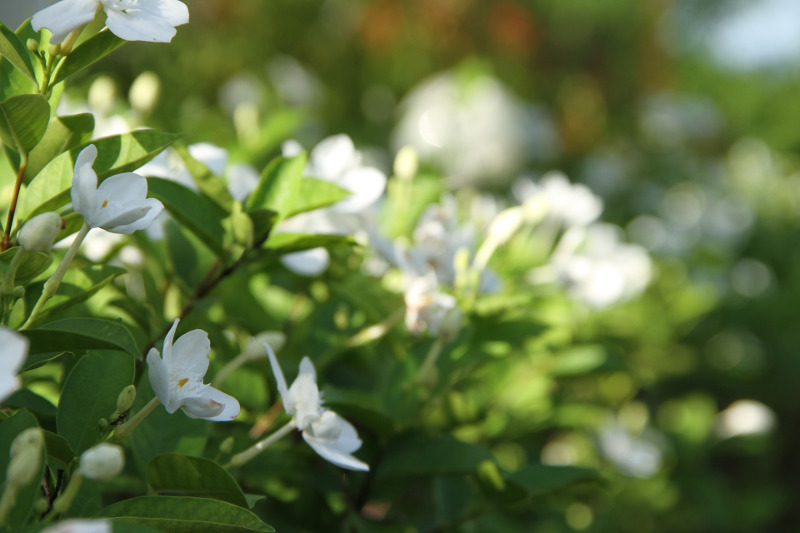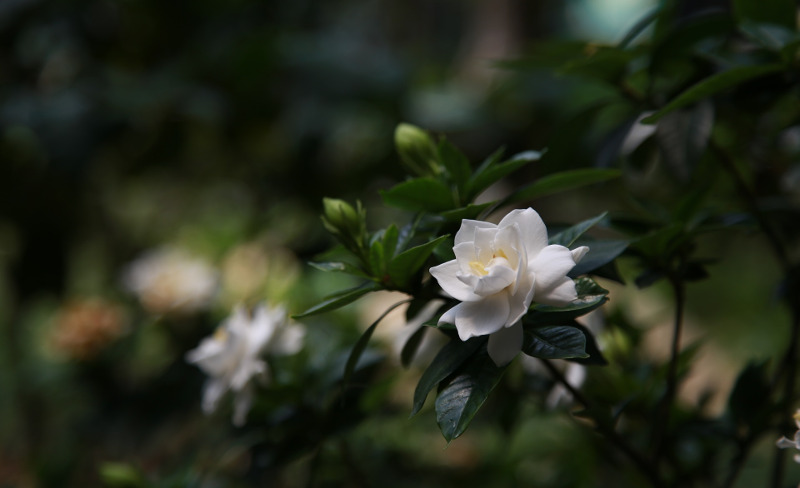Gardenias can be a little challenging to grow, but people grow them for their swoon-worthy fragrance, elegant rose-like flowers in spring and summer, and dressed-up glossy leaves. Native to humid tropical and subtropical Africa, southern Asia, Australasia and Oceania, this genus of shrubs sits botanically in the coffee family, Rubiaceae. In height they span from three feet to 50.
Gardenia jasminoides is famous as a fairly finicky house plant, while its fruits are popular for medicinal uses in China. They prefer bright light with protection from the afternoon sun, temperatures of 66-74 degrees F (20-23 C), high humidity, and acidic soil between a pH of 5 and 6. In the US they are typically hardy from USDA zones 8-10, but some cultivars, are more frost-proof, such as ‘Klehm’s Hardy’ (zone 7-10), and ‘Chuck Hayes’ (6-10).

Planting Gardenia
Choose a gardenia hardy to your climate zone, or plan to take inside as a houseplant in winter. Find a location for your gardenia that is protected from the afternoon sun or drying winds, and that has consistent moisture and soil high in nutrients and organic matter.
In cool climates, they can take more sun if they are mulched and well-watered. An exposed roof deck or high-rise patio would not be a gardenia’s happy place. The soil should be acidic, with a pH from 5 to 6.
Often locations near concrete foundations are too alkaline. Dig a hole twice as wide and as deep as the root ball. Water well, and mulch to keep roots moist and cool.
Watering Gardenia
Gardenias don’t like to dry out, but neither do they like wet feet. They like that sweet spot of “moist and well-drained” soil conditions. Going too wet or too dry can cause buds to close up or drop off. Give your gardenia at least an inch of water per week, more while getting established during dry or hot weather.
Keep your plant mulched to preserve moisture at the roots. Two to four inches is a good depth for mulching with organic matter like composted leaves. Indoors, to drain away excess fertilizer salts, water with distilled water monthly.
Fertilizing Gardenia
Gardenias are pretty hungry feeders. You can help their soil biome with organic matter like compost and manure in the fall. During the growing season (spring through fall), apply a diluted acidic fertilizer every two to four weeks. From November through February, take a break from fertilizing to give the plant a rest during dormancy. In spring, resume fertilizing.

Pruning Gardenia
The best time to prune gardenia for shaping is right after blooming. If done while dormant in a marginally hardy zone, pruning can encourage new vulnerable growth that could be cut down in a frost. Remove any broken or damaged growth. Lightly shape as needed, making cuts at the base or the center of the shrub. Clear any diseased foliage. To renew a mature shrub, remove 1/3 of the stems at the base every year for three years. While blooming, cutting bouquets and deadheading spent blooms will foster new blooms.
Caring For Gardenia in Pots
When temperatures are over 55 degrees F, you can plant a potted gardenia outdoors. Choose a gardenia hardy to your climate zone, or plan to take inside as a houseplant in winter. Find a location for your gardenia that is protected from the afternoon sun or drying winds.
The soil should be acidic, with a pH from 5 to 6. Mixing in one or two handfuls or coffee grounds into your potting mix will improve the acidity. Make sure your pot has good drainage and is at least four inches wider than the root ball.
Dig a hole twice as wide and as deep as the root ball. Water well, and mulch to keep roots moist and cool. Water at least once a week, more if conditions are hot or dry. Mulch at least two inches deep to preserve moisture. Fertilize every other week with a liquid fertilizer for acid-loving blooming plants.
In winter, if borderline hardy to your area, protect the pot with frost cloth and move against a warm but sheltered wall. If not hardy, bring inside, cut back on watering, put in a bright morning sun location, and stop fertilizing. Try to ensure warm days and cool night temperatures. Mist regularly or use a humidity tray.

Winter Care for Gardenia
In fall, amend soil as needed with organic matter. Replenish mulch to a depth of two inches minimum. In winter, if borderline hardy to your area, protect the pot with frost cloth and move against a warm but sheltered wall. Stop fertilizing. If not hardy, bring inside, cut back on watering, put in a bright morning sun location.
Try to ensure warm days and cool night temperatures. Mist regularly or use a humidity tray. Resume fertilizing when new growth begins outside, and when you bring your indoor plant out once temperatures are over 55 degrees F.
Gardenia For Sale
Common Gardenia Care Questions
Why Are My Gardenia Leaves Turning Yellow?
The most common cause of yellowing leaves on gardenias is an iron deficiency in the soil, they need soil with a pH level between 5.0 and 6.5. Using an acidic fertilizer should easily remedy the issue.
Are Gardenia Drought-Tolerant?
Gardenias are not drought tolerant, preferring evenly moist soil to either wet, soggy feet or dried out soil, either one. Surrounding them with a few inches of mulch will not only help keep moisture even, but it will also help keep the roots dry in the heat of the summer.
Do Gardenias Like Sun Or Shade?
Gardenias do best in full sun, but in the warmest climates of their hardiness zones, may appreciate some shade during the hottest parts of the day.
Are The Gardenias Indoor Or Outdoor Plants?
Gardenias can be grown both indoors and outdoors! In zones 8-11 they can generally be left outside year-round. In other zones, they'll need to be brought in in the fall, until spring. Any time nighttime temperatures are going to be below 60 degrees Fahrenheit, they should be brought indoors.
How To Care For Gardenia Indoors?
When growing gardenias indoors, they should be kept in a room that is fairly warm with bright but indirect sunlight (especially during the hottest part of the year.) The soil should be kept consistently moist, with reduced watering during the winter.
Can Gardenias Be Grown Into A Hedge?
Gardenias make a beautiful, showy, hedge when planted together, and for best performance, deadheading should be frequent.
Have a question about Gardenia? Fill out the form below and we will try and get back to your question as soon as possible. We may even feature your question on this article to help other gardeners!
 |
Author Erica Browne Grivas - Published 08-02-2021 |
